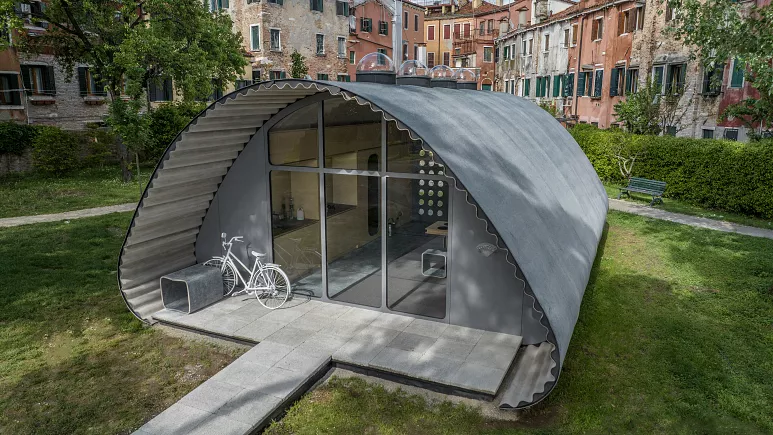Norman Foster Creates A Forward-thinking Emergency Shelter At The Venice Biennale
Norman Foster creates a forward-thinking emergency shelter at the Venice Biennale. A set of rapid-assembly structures that can be created on site and that are resistant to the weather following natural disasters have been unveiled by the British architect Norman Foster.
Author:George EvansMay 25, 202339.4K Shares858.1K Views

Norman Foster creates a forward-thinking emergency shelterat the Venice Biennale. A set of rapid-assembly structures that can be created on site and that are resistant to the weather following natural disasters have been unveiled by the British architect Norman Foster.
During the past few days, flooding in northern Italy has forced at least 36,000 people to seek refuge elsewhere, while earthquakes in Turkey and Syria in February forced about 2.5 million people to seek refuge elsewhere.
The victims of catastrophes like these are sometimes forced to seek refuge in hurriedly built tents or in rows of prefabricated cottages that are made of weak materials.
Now, at the 2023 Venice Architecture Biennale, the Norman Foster Foundation has shown a newly built emergency shelter that aims to revolutionize housing for those who have been displaced by natural disasters.
The Essential Homes Research Project was developed through a partnership between the foundation that was founded by the architect and the concrete company Holcim.
The prototype of an emergency construction that was supposed to last for up to twenty years is now being exhibited in Venice.
The time scale serves as a depressing reminder that most of the so-called "temporary" accomodation ends up becoming quasi-permanent as displaced populations learn to adjust to their new environments. According to research conducted by the United Nations, families remain in emergency housing for an average of 17 years.
Foster said in an interview:
“„Disasters lead to the need for instant accommodation and camps – mostly tented – offering scant protection from the elements. What if there would be something that would be more permanent, more durable, offering greater protection from the elements, but which could be realised very quickly?- Foster
In the Marinaressa Gardens, which are located right next door to the Giardini, where many of the national pavilions of the Biennale are housed, visitors may view a replica of Foster's emergency shelter that is built to size. The framework was conceived as a building that could be erected quickly and easily on location while still withstanding the effects of the weather.
It features a structure in the shape of an arch, and over it is draped a rollable outer shell, giving it a little bit of the appearance of a bomb shelter from the period of war. This low-carbon concrete canvas, after being sprayed with water and let to dry for a day, will harden into a firm form.
Insulation may be found on the interior, and the exterior layer is watertight. The basis of the shelter is constructed from recycled building rubble, which is not difficult to get in the aftermath of a natural disaster.
Eco-friendly Emergency Shelter
Edelio Bermejo, Holcim's chief of research and development, has also emphasized the shelter's eco-friendliness. It emits 70% less carbon than standard houses and, if required, may be dismantled and repurposed. The accommodation is also intended to be long-lasting, with a life expectancy of at least two decades.
3D Printing And Flat Pack Emergency Housing
Other initiatives to enhance disaster housing include the non-profit Ikea Foundation's Better Shelter, a flat-pack building meant to survive up to three years. Shigeru Ban and Yasmeen Lari, architects, have experimented with numerous emergency shelter alternatives, such as mud buildings.
Mario Cucinella, an architect, proposed a 3D printed earth house in 2021 that can be built in 200 hours using local dirt. As the framework is printed, basic interior furnishings are also created.
Final Words
Norman Foster's visionary designs have left an indelible mark on the architectural landscape, showcasing his ability to merge aesthetics, sustainability, and cutting-edge technology. With his unwavering commitment to innovation, Foster continues to shape our cities, redefine architectural norms, and inspire future generations of designers.

George Evans
Author
George Anderson, an exceptional architectural designer, envisions and brings to life structures that transcend the realm of imagination. With an unwavering passion for design and an innate eye for detail, George seamlessly blends form and function, creating immersive spaces that inspire awe.
Driven by a deep appreciation for the interplay of space, light, and materials, George's innovative approach redefines the possibilities of architectural design. His visionary compositions leave an indelible mark, evoking a sense of wonder and transforming the built environment.
George Anderson's transformative designs and unwavering dedication continue to shape the architectural landscape, pushing the boundaries of what is possible and inspiring generations to come.
Latest Articles
Popular Articles